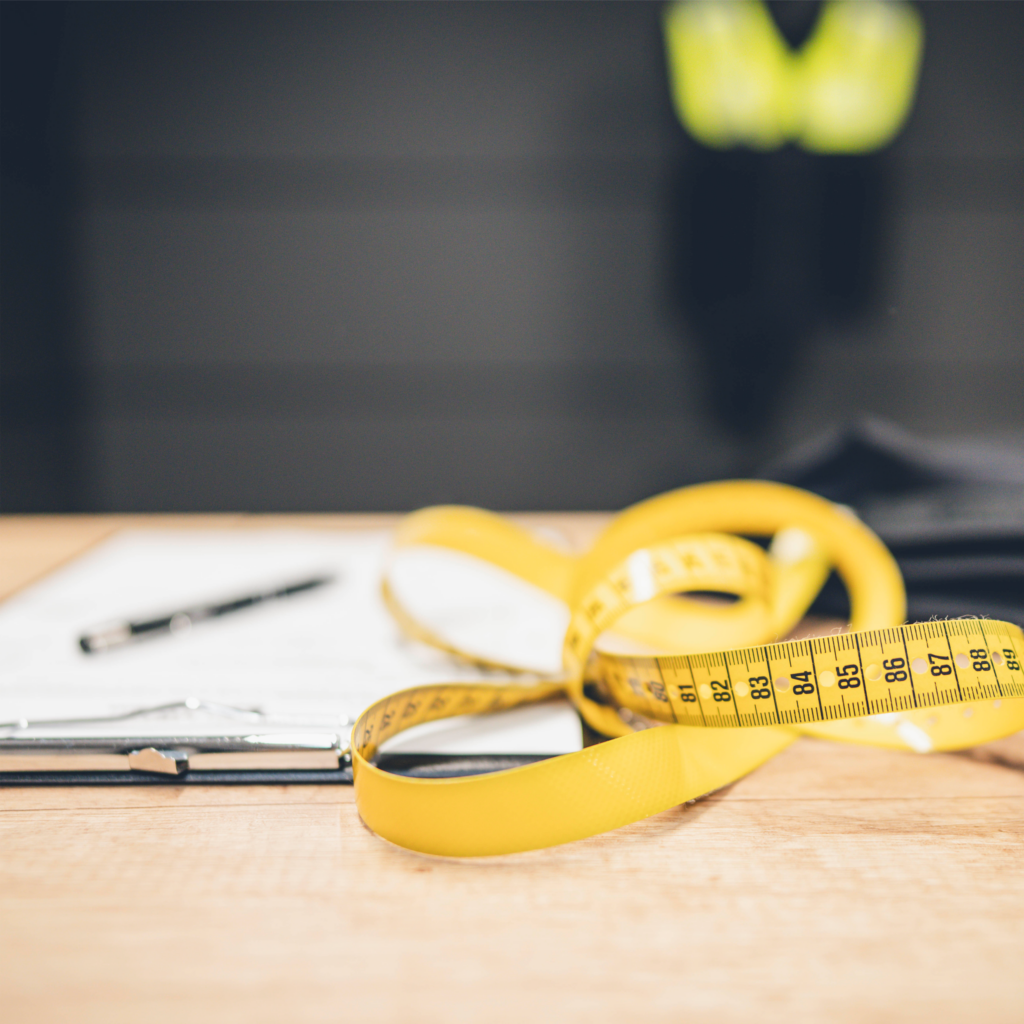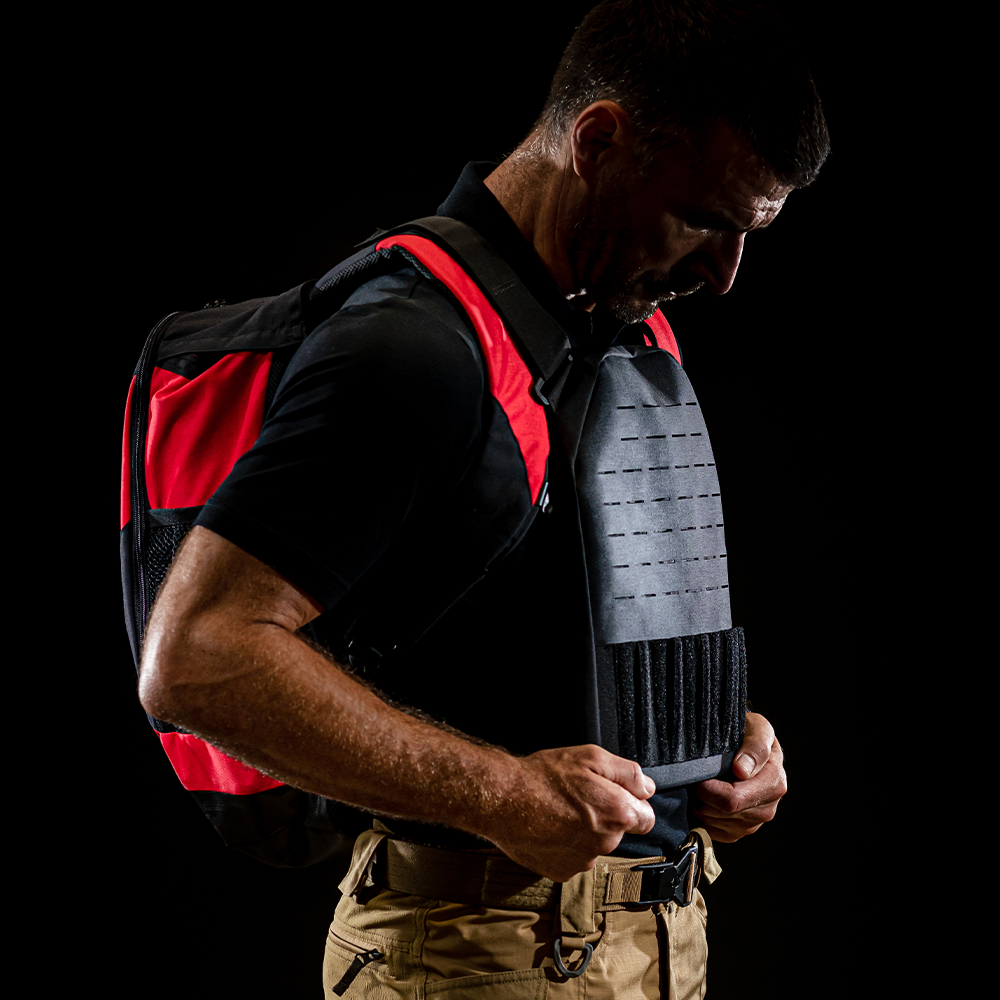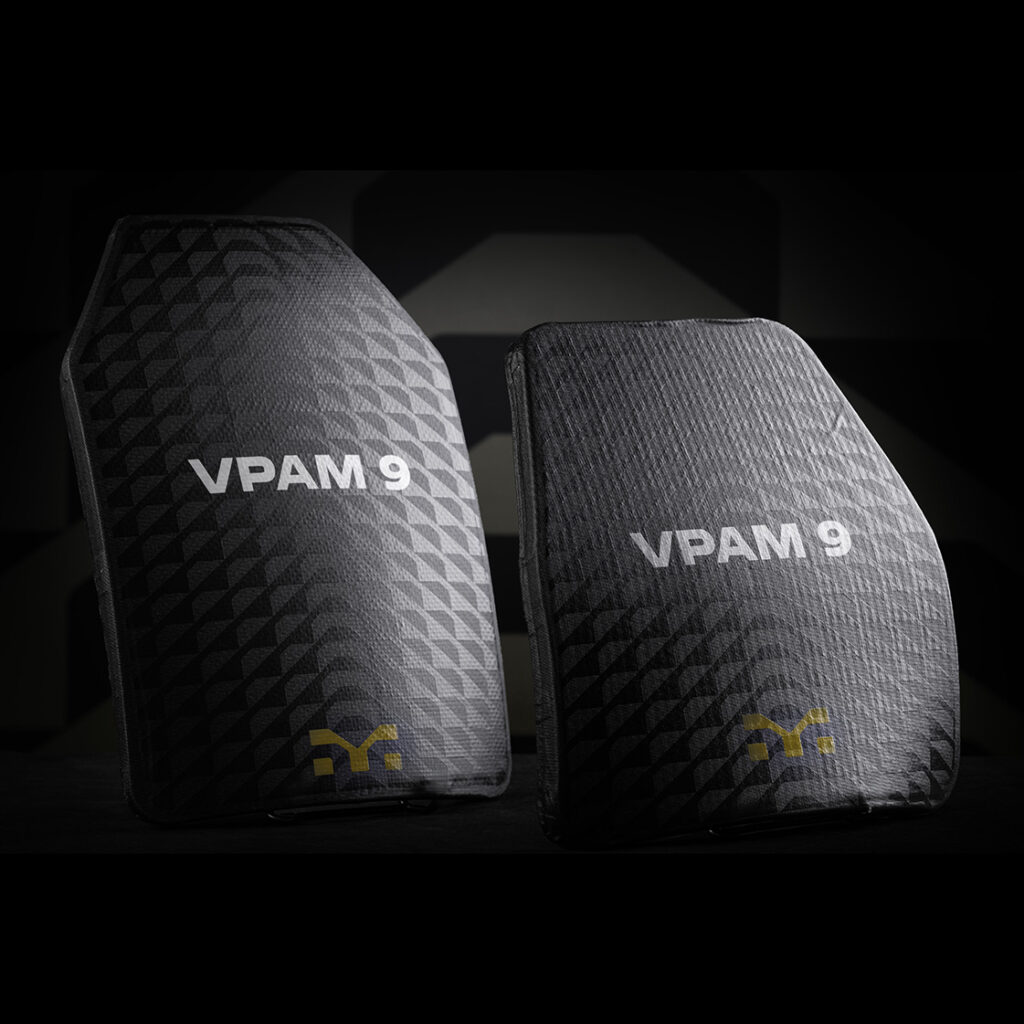
Ballistic protection: Protective elements and standards
Global conflicts are increasing. They are increasing in number, frequency, and intensity. It is against such a backdrop that the issue of personal ballistic protection becomes more and more important. Contained within this issue is the question of what ballistic protection level is required to keep military and law-enforcement personnel safe when they deploy into these global conflicts. The answer is it depends. What it depends on is the threat situation and the protection packages or plates selected in response to it.
In this blog post, we explain what constitutes a ballistic protection element, how to differentiate between two or more such elements, and what protection standards those elements must meet. We also go into some detail about the relevant materials used in the manufacture of ballistic protection.
Soft ballistics vs. hard ballistics
Ballistic protection elements are integral to the personal protective equipment of every police and military unit. These elements enable the user to defend against threats of various types and, typically, are applied in bullet-resistant vests and plate carriers.
In general, protective elements are intended to safeguard the user against bullet shots, bladed-weapon stabs, and other forms of attacks that would otherwise result in life-threatening injuries. The role of these elements is to reduce incoming energies to such an extent that the projectile or implement cannot penetrate the flesh of the wearer’s body.
Ballistic protection elements can be divided into soft-ballistic packages (soft ballistics for short) and hard-ballistic panels/plates (or simply hard ballistics).
Soft ballistics are designed to reduce the potential for bodily trauma by protecting against projectiles fired from pistols or submachine guns. Soft ballistics can be combined with stab and impact protection to provide additional shielding from knives, needles, splinters blows, collisions, falls, and more.
A wide range of soft ballistics exists. Available are individual protection paraphernalia for the neck, shoulders, legs, arms, abdomin, hands, forearms, sides and flanks, chin, front and back, throat, thighs, knees, and groin (see image below).
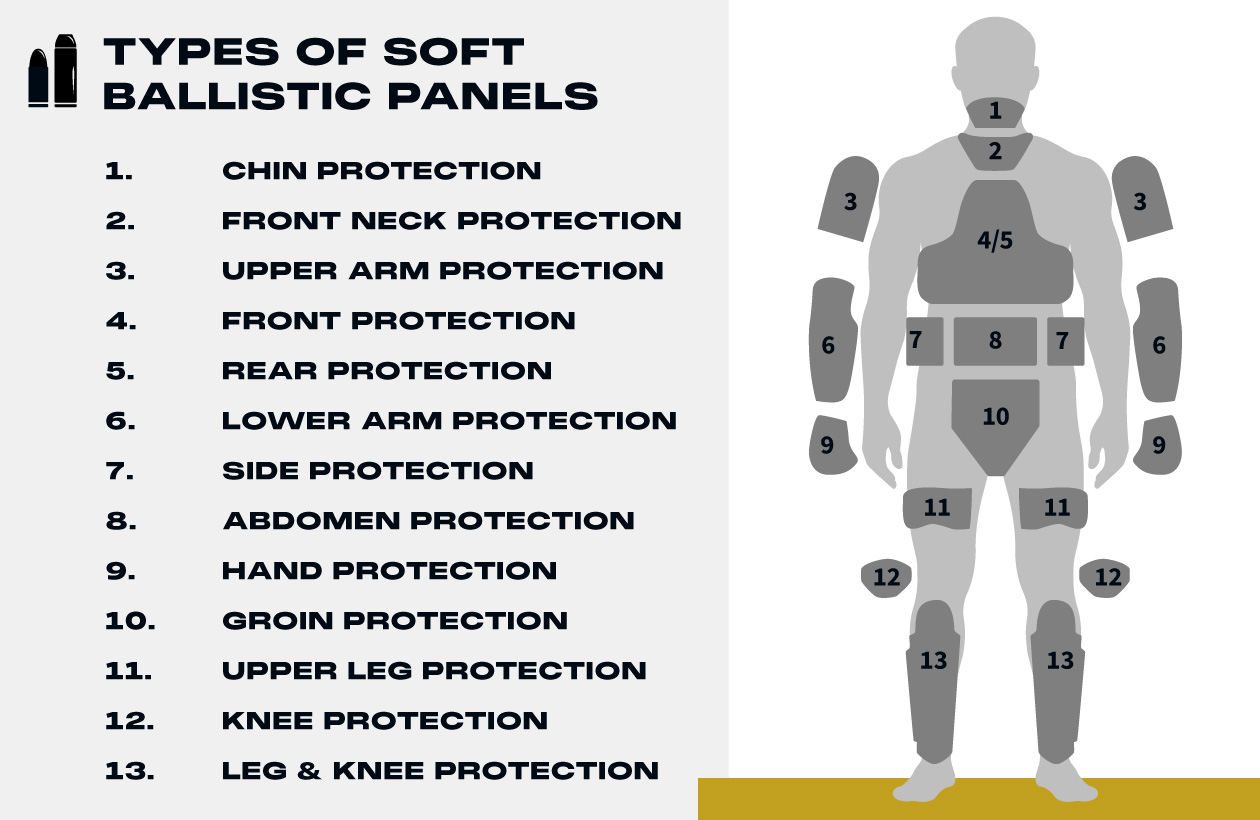
Hard ballistics, on the other hand, are designed to protect against projectiles fired from long guns. Due to the barrel length of these weapons, projectiles shot from them can possess greater mass and travel at higher velocity than can those fired from pistols and submachineguns. Those characteristics make long-gun projectiles abundantly dangerous to begin with, but since their core can be made of either soft or hard materials, their potential for lethality is all the more profound.
It is not uncommon for hard ballistics to be used in conjunction with soft ballistics, as the “plate” is usually positioned to protect only the primary vital areas of the wearer’s body.
In practice, hard ballistic plates are most often used for abdominal, lower body, leg, throat, side-and-flank, thigh, front-and-back, and arm protection (amongst other areas of the body). Hard ballistics also are used in the production of helmets (see image below).
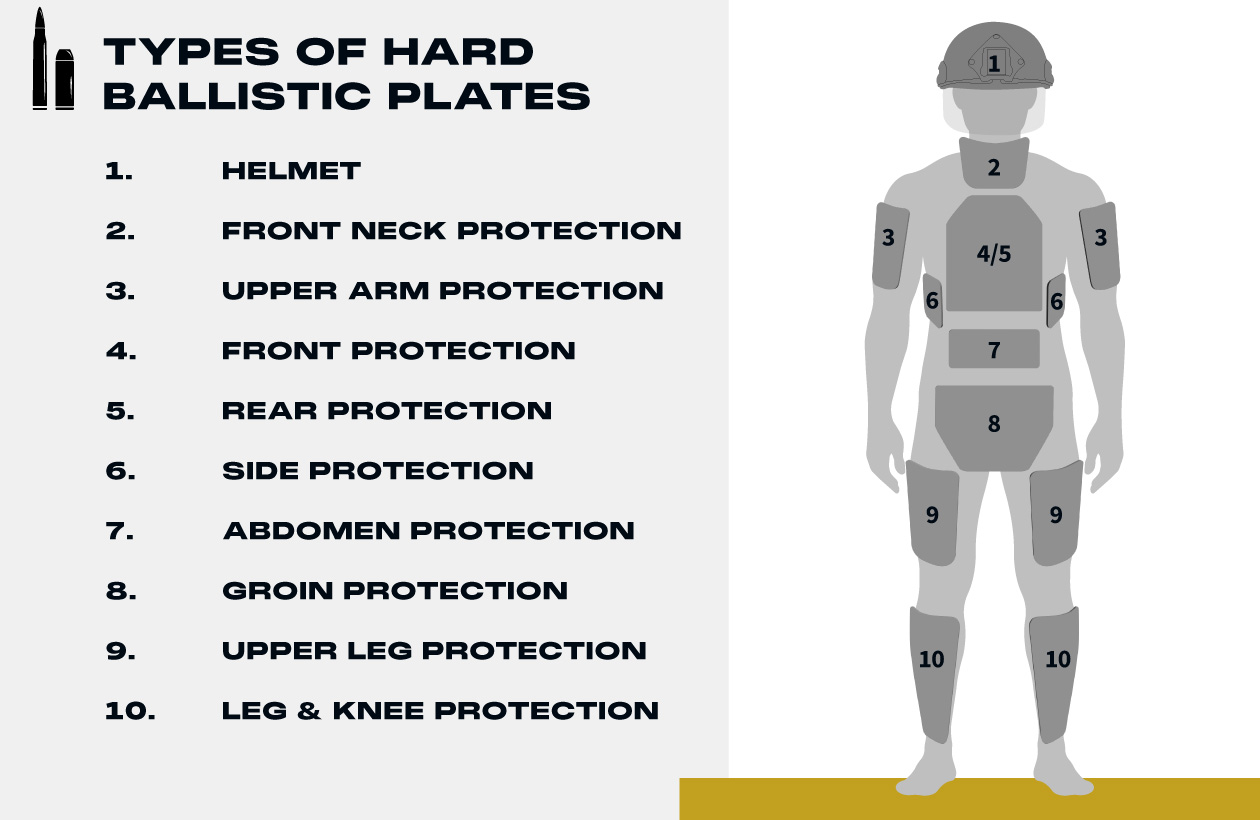
Ballistics of both the soft and hard type for plate carriers, protective vests, and accessories are customarily placed within a protective cover.
"Standalone" vs. "in conjunction with"
Ballistic protection elements are usually presented as one of two types of solutions: standalone (SA) or “in conjunction with” (ICW).
An SA solution is one in which only a single component is used. The one-component nature of the solution theoretically makes it easier to handle. An ICW solution, on the other hand, is understood to be a soft or hard ballistic paired with at least one other component. For example, you could have a soft ballistic panel, a trauma-reducing element, and a hard ballistic plate together. It is important that both types of ballistic protection elements be worn together in order to provide full protection.
Protection standards
There are several considerations that go into choosing suitable hard or soft ballistics, beginning with the required protection class and extending to weight, comfort, and price.
As a rule of thumb, lower-quality components weigh more while a higher price is to be expected for lighter components.
Hard ballistics are most often employed in higher protection classes; soft ballistics in lower protection classes. The latter can be upgraded as needed with elements to provide impact and stab protection. The most common guidelines are listed below.
Soft ballistics
- NIJ (America)—NIJ I, NIJ II, NIJ IIA, NIJ IIIA
- VPAM (Europe)—VPAM 1, VPAM 2, VPAM 3, VPAM 4, VPAM 5
- CAST (England)—HO1, HO2, KR1
- TR (Germany)—SK1, SK2
Hard ballistics
Materials
Soft ballistics
Soft ballistics used in low protection classes consist typically of several layers of textile fibres, such as para-aramid and high-performance polyethylene (HPPE), to provide effective protection against short-barrelled weapons (i.e., pistols and submachine guns).
Sunlight, temperature, humidity, and other environmental factors can adversely affect some synthetic materials, causing their fibres to poorly absorb bullet energy. For this reason, packages are sized with appropriate reserves and usually shrink-wrapped in plastic films or other textiles designed for this purpose.
To improve user comfort, materials are fixed in a few places within their textile sleeves.
Hard ballistics
Ordinarily sufficient to meet the requirements of medium protection classes is a pure polyethylene plate. However, to satisfy highprotection-class specifications, the plate must be made of aluminum oxide, silicon carbide, boron carbide, or other type of ceramic material.
Unfortunately, ceramics by themselves lack the capacity to withstand bombardment unless they are of an appropriate thickness. Trouble is, increasing its thickness makes a ceramic plate heavier. To satisfy protection requirements, a ceramics-only plate must be quite thick—which means it is also weighty, and that makes such a plate impractical for the user. For this reason, manufacturers prefer to keep ceramic plates thin. They are made able to withstand bombardment by reinforcing them and adding a “backing” to absorb what remains of bullet energy (as well as to reduce impact-produced trauma).
How the ceramics are reinforced is a closely guarded trade secret (at least it is among most manufacturers, including us). Not so the backings. It is common knowledge that the backings are made of polyethylene scrims or aramid fabric, then bonded to the reinforced ceramic by high-temperature/high-pressure compression.
Backing materials are sourced from manufacturers around the world. These materials must be within tight tolerances in order to ensure consistent quality of the finished safety product—and to be able to sell it with a clear conscience.
Accordingly, all Mehler Vario System ballistics undergo a process by which corresponding production specifications and quality controls are defined and then continuously checked and documented throughout the various stages of manufacture (all of which is performed in-house at our facilities in Germany).
Specifications
Our customers specify their ballistic-element requirements. We leave it to them to tell us which standard or guideline (including NIJ, VPAM, CAST) they want applied and which protection class must be attained. We also rely on the customer to define other basic parameters, including product size, shape, and weight.
We frequently receive customer-supplied specifications for ballistics capable of withstanding variant bullet types, those not listed in the common standards. Certification of the resultant product requires the performance of special tests; these are conducted in our own laboratory.
Plate cuts
Ballistic plates differ not only by materials but also by size and shape (cuts). The way a plate is cut greatly influences the protective surface, weight, and user’s mobility.
The four most common cuts are: Shooter’s, Swimmer’s, SAPI, and Full. All can be customised by the manufacturer; the extent of customisation depends on the product’s shape and weight.
Shooter’s cut
The Shooter’s cut involves a rectangularly shaped plate that has its corners angled or removed to give users more freedom of movement, especially their arms.

Swimmer’s cut
The Swimmer’s cut removes the entire upper portion of the plate. This favorably affects freedom of movement in the shoulders and back. However, it results in less protection for the wearer than does the Shooter’s cut.
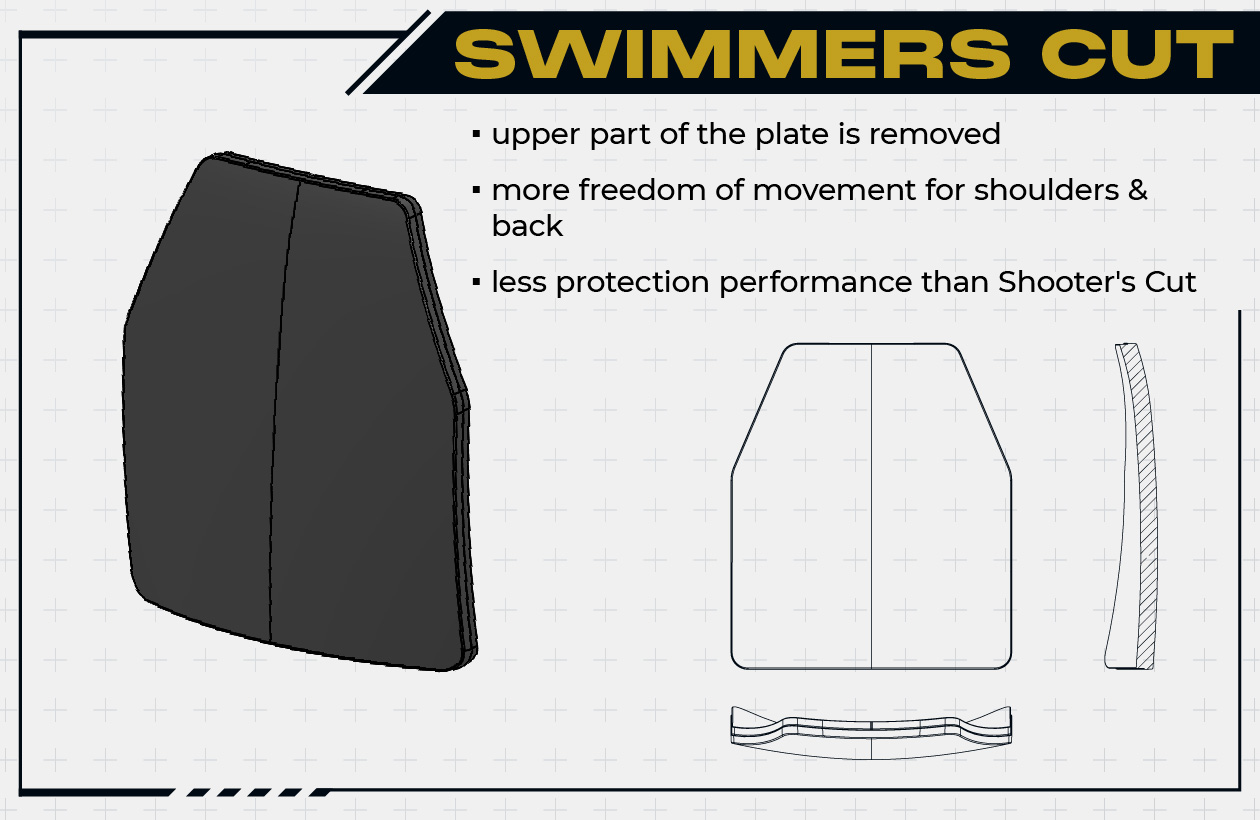
SAPI
SAPI stands for Small Arms Protective Inserts. Here, a rectangular plate is obliquely cut at each of its top corners. The SAPI cut protects the user better than does a plate with a Swimmer’s cut because the former leaves more protective surface.
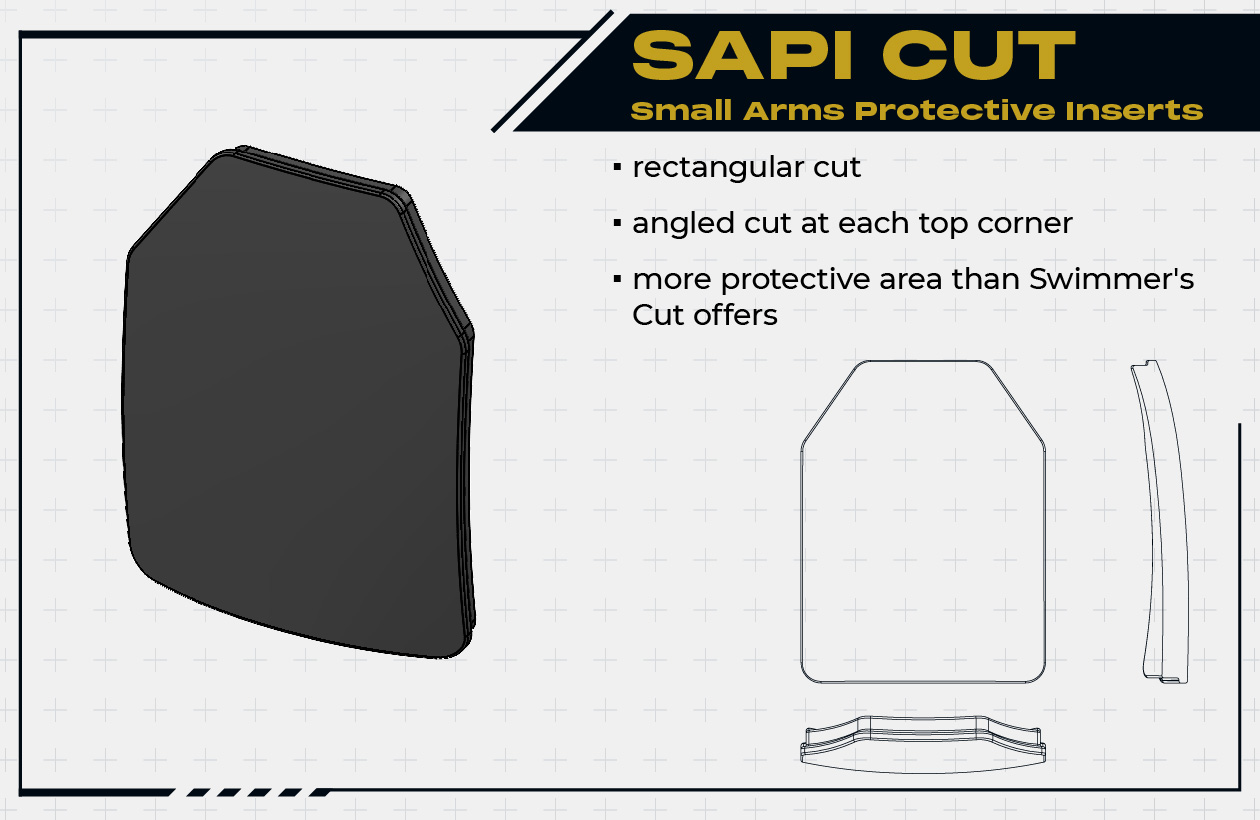
Full cut
Full cut refers to a square or rectangular excision most often made to plates designated for placement on the wearer’s back or sides. Compared to the other cuts, the Full cut yields perhaps the least amount of freedom of movement.
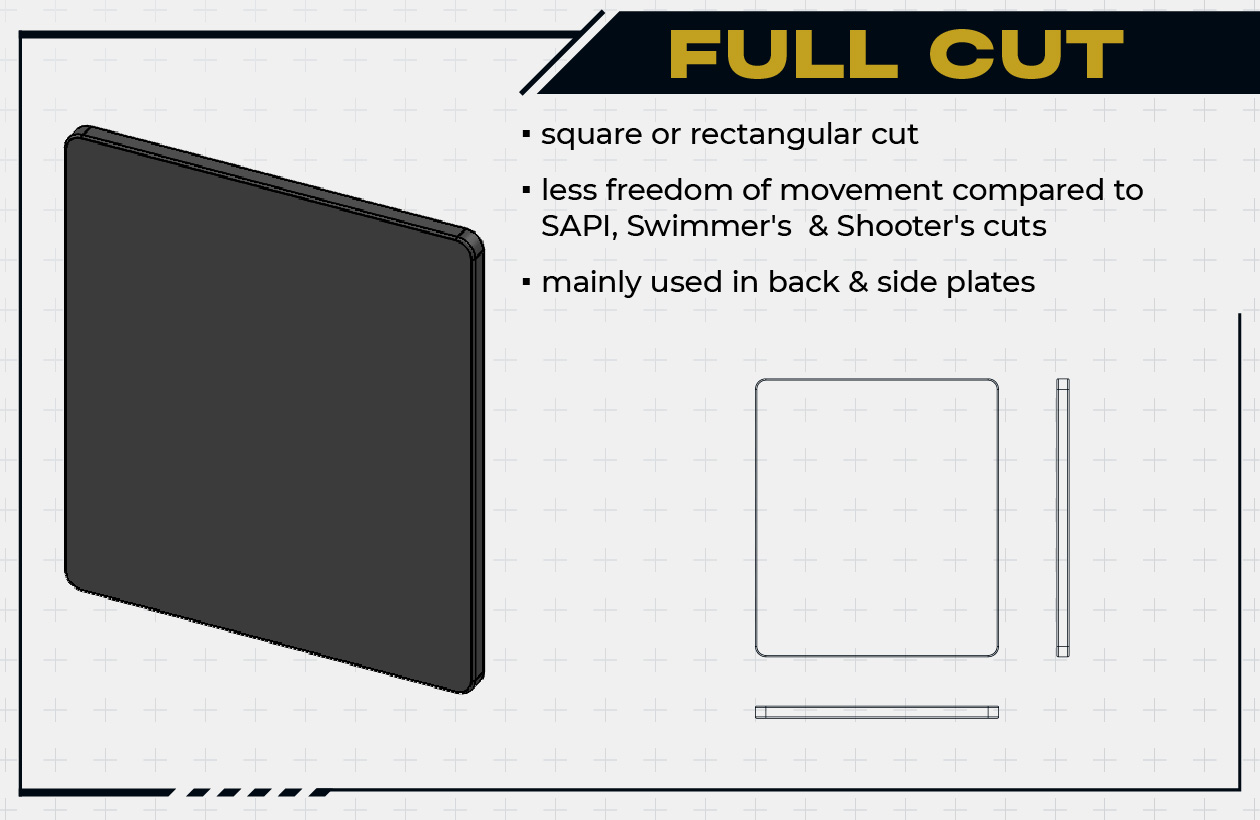
Summary
Ballistic protection elements come in different sizes, shapes, weights, materials, protection classes, and threat-handling prowess.
A basic distinction is made between soft ballistics (protection against short-barrelled weapons and against stabs and strikes) and hard ballistics (protection against long-barrelled weapons), either of which can be worn as a “standalone” or “in conjunction with” solution.
Currently, the most common (and, within limits, customisable) plate cuts are: Shooter’s, Swimmer’s, SAPI, and Full. The two primary limiting factors when it comes to customisation are plate shape and weight.
Which materials will be used to make soft and hard ballistics depend on which protection class the customer wishes the finished product to attain. Textile fibres are used when the finished product is aimed at qualifying for a lower protection class (as is typically the case with soft ballistics); when aimed at qualifying for a mid-range or higher protection class (hard ballistics), used instead are polyethylene or ceramics (such as aluminum oxide, silicon carbide, and boron carbide).
The effectiveness of soft ballistics can be augmented with impact and puncture protection, as required.
